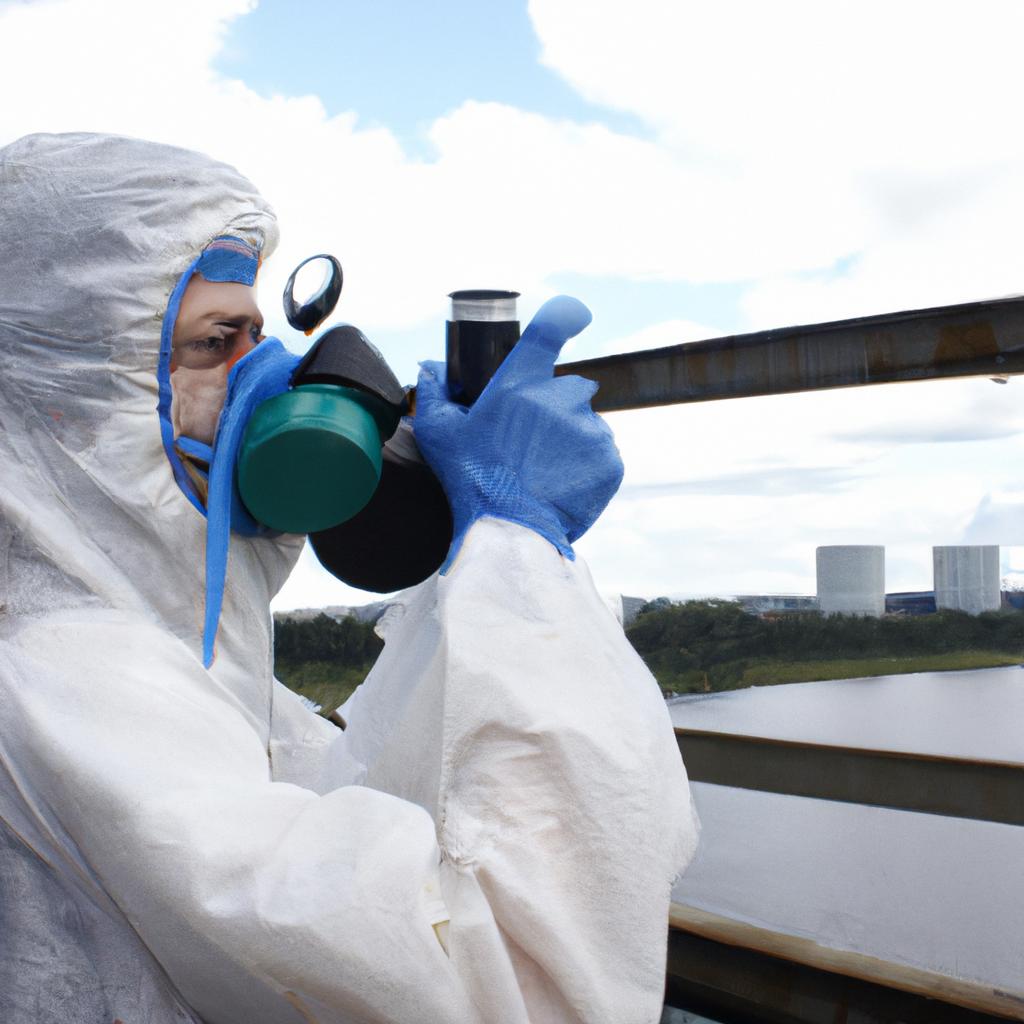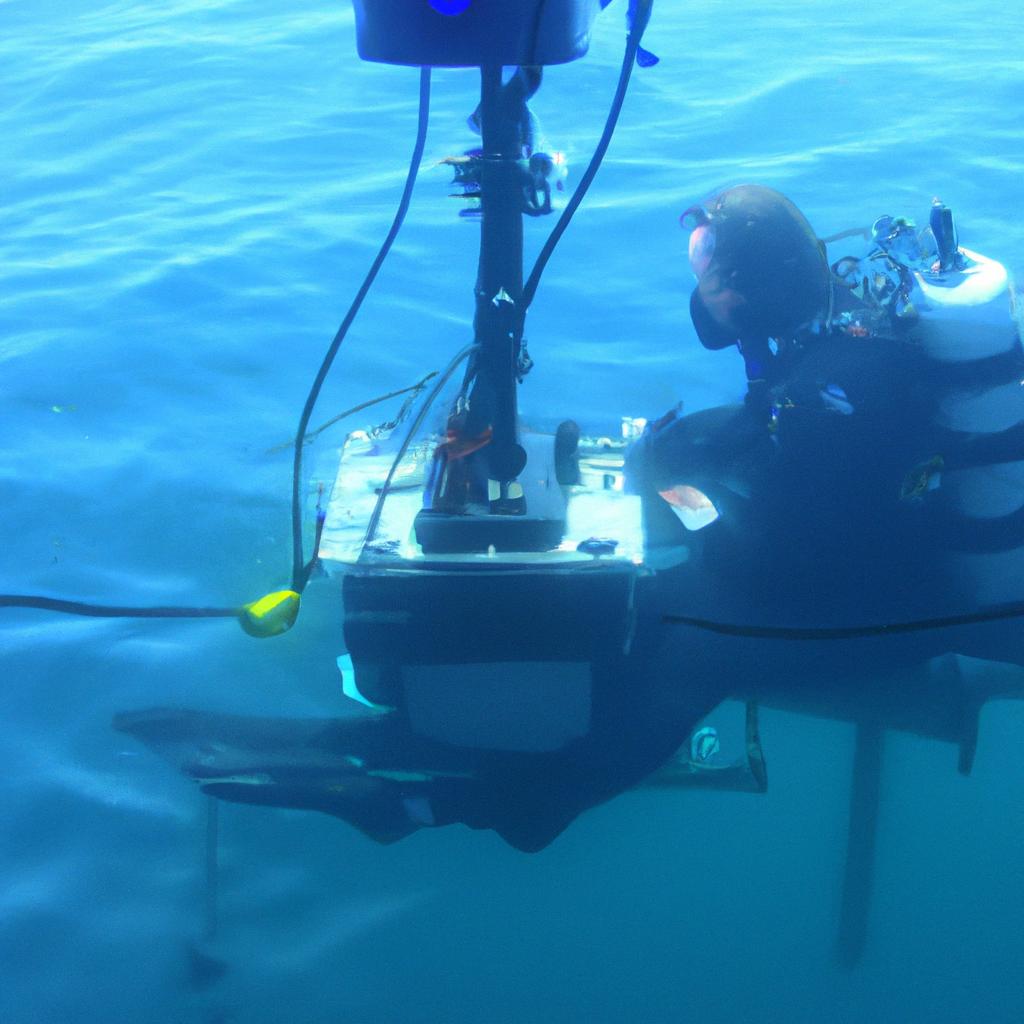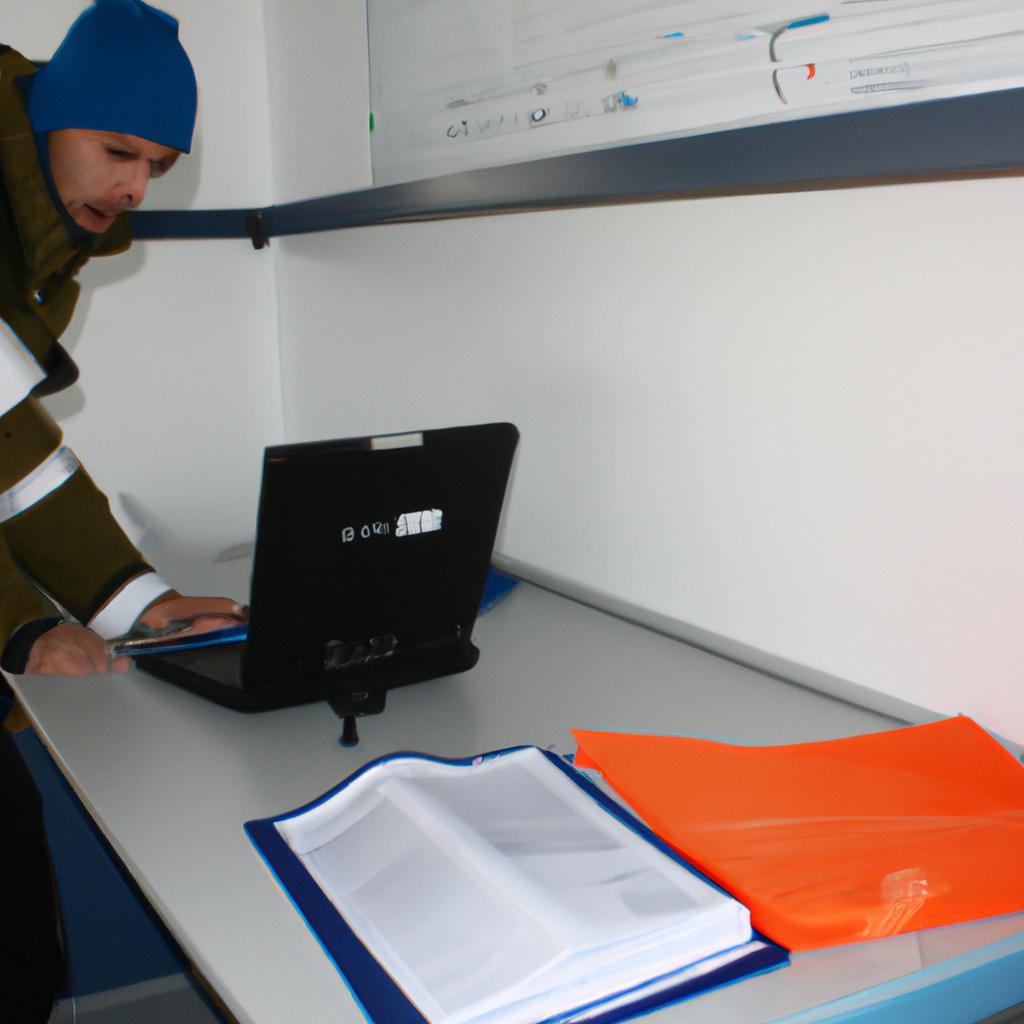Environmental conservation plays a crucial role in the field of geo-financial earth sciences, as it encompasses various disciplines that examine and analyze the intricate relationship between human activities and the environment. One compelling example is the case study of a mining operation in a remote region, where extensive extraction of natural resources has resulted in severe ecological damage. This scenario underscores the urgent need for comprehensive understanding and implementation of environmental conservation measures within the realm of geo-financial earth sciences.
In recent years, there has been increasing recognition among researchers and policymakers regarding the importance of integrating environmental conservation practices into geo-financial earth sciences. With global concerns about climate change, resource depletion, and biodiversity loss reaching unprecedented levels, it becomes imperative to address these issues from multiple perspectives. By examining how economic processes interact with geological phenomena, such as mineral exploration or oil extraction, we can gain valuable insights into sustainable strategies that ensure both financial viability and environmental preservation.
This article aims to provide a comprehensive overview of environmental conservation within the context of geo-financial earth sciences. It will explore key concepts, methodologies, and best practices employed in this interdisciplinary domain. Additionally, it will delve into specific case studies to highlight successful approaches taken by industry leaders and governmental bodies towards mitigating negative environmental impacts while balancing economic interests. Through these case studies, readers will gain a deeper understanding of the challenges faced in achieving sustainable development and the innovative solutions that have been implemented.
One essential aspect of environmental conservation within geo-financial earth sciences is conducting thorough environmental impact assessments (EIAs) before commencing any extraction or development activities. EIAs involve evaluating potential environmental risks and impacts, such as habitat destruction, water pollution, or greenhouse gas emissions. By identifying these risks early on, appropriate mitigation measures can be put in place to minimize damage and ensure long-term environmental sustainability.
Furthermore, integrating ecosystem services into decision-making processes is crucial for effective environmental conservation. Ecosystem services refer to the benefits provided by ecosystems to humans, such as clean air and water, pollination, climate regulation, and recreational opportunities. Recognizing the value of these services helps prioritize conservation efforts and promotes the incorporation of nature-based solutions into geo-financial projects.
Collaboration between stakeholders is another vital component of successful environmental conservation in this field. This includes engaging with local communities, indigenous groups, government agencies, non-governmental organizations (NGOs), and industry representatives. By involving all relevant parties in planning and decision-making processes, a more holistic approach can be taken towards balancing economic interests with environmental protection.
In conclusion, environmental conservation plays a pivotal role in geo-financial earth sciences by addressing the complex interplay between human activities and the environment. This article has provided an overview of key concepts and methodologies employed in this interdisciplinary domain. Through case studies highlighting successful approaches taken by industry leaders and governmental bodies towards mitigating negative environmental impacts while balancing economic interests, readers are encouraged to explore innovative solutions for achieving sustainable development in our ever-changing world.
Importance of Environmental Conservation
Environmental conservation plays a crucial role in ensuring the sustainability of our planet and the well-being of all its inhabitants. By preserving natural resources, protecting biodiversity, and mitigating climate change, environmental conservation provides countless benefits to both present and future generations. To illustrate this point, let us consider the case study of deforestation in the Amazon rainforest.
Deforestation in the Amazon is an alarming issue that highlights the significance of environmental conservation. The vast destruction of trees not only disrupts delicate ecosystems but also contributes significantly to greenhouse gas emissions. This example demonstrates how failing to conserve our environment can have far-reaching consequences on a global scale.
To further emphasize the importance of environmental conservation, here are four key reasons why it should be prioritized:
- Preservation of Ecosystems: Conserving natural habitats ensures the survival of diverse species and maintains ecological balance.
- Protection against Natural Disasters: Maintaining healthy ecosystems aids in minimizing the impact of disasters such as floods, droughts, and landslides.
- Sustainable Resource Management: Responsible use and management of natural resources help maintain their availability for future generations.
- Health and Well-being: A clean environment with reduced pollution levels positively impacts human health and overall quality of life.
Additionally, we can visualize these benefits through a table that outlines different aspects affected by environmental conservation:
| Aspect | Positive Impact |
|---|---|
| Biodiversity | Preserves rich variety of species |
| Climate Stability | Reduces greenhouse gas emissions |
| Water Resources | Ensures access to clean water |
| Soil Fertility | Supports sustainable agriculture |
Considering these factors, it becomes evident that prioritizing environmental conservation is essential for safeguarding our planet’s long-term stability and promoting human welfare.
Transitioning into the subsequent section about “Key Factors Affecting Environmental Conservation,” it is important to understand various elements that influence effective preservation efforts. By exploring these factors, we can gain insights into how to address the challenges and enhance environmental conservation practices.
Key Factors Affecting Environmental Conservation
Section H2: Key Factors Affecting Environmental Conservation
Building upon the understanding of the importance of environmental conservation, it is crucial to examine the key factors that significantly influence its effectiveness. By comprehending these factors, we can develop strategies and policies that address underlying issues and foster sustainable practices. This section delves into some of the main influences on environmental conservation.
Factors Influencing Environmental Conservation:
-
Economic considerations:
- The economic incentives for industries often prioritize short-term gains over long-term sustainability.
- Governments must strike a balance between economic growth and ecological preservation.
- Policies promoting environmentally friendly practices can help align economic interests with conservation goals.
- Incorporating externalities such as carbon pricing can incentivize businesses towards adopting greener alternatives.
-
Population growth and urbanization:
- Rapid population growth exacerbates resource consumption, leading to increased pressure on ecosystems.
- Urbanization contributes to habitat destruction, deforestation, and pollution due to concentrated human activities.
- Effective urban planning that incorporates green infrastructure can mitigate negative impacts on the environment.
- Encouraging sustainable lifestyles through education and awareness campaigns is vital in managing population growth’s effect on conservation efforts.
-
Climate change:
- Rising global temperatures, melting ice caps, and extreme weather events pose significant challenges to biodiversity and natural habitats.
- Mitigating climate change requires reducing greenhouse gas emissions through renewable energy adoption and improved energy efficiency measures.
- Adaptation strategies need to be implemented to protect vulnerable ecosystems from changing climatic conditions.
-
Political will and international cooperation:
- Environmental conservation necessitates strong political will at both national and international levels.
- Collaborative efforts among governments are essential for addressing transboundary environmental issues like air pollution or oceanic degradation.
- International agreements like the Paris Agreement provide frameworks for countries to work together toward common environmental objectives.
- Loss of biodiversity is irreversible and leads to the extinction of numerous species.
- Environmental degradation affects human health by increasing the prevalence of diseases.
- Natural disasters are amplified due to environmental deterioration, resulting in loss of life and property damage.
- The depletion of natural resources jeopardizes future generations’ ability to meet their needs.
Emotional table:
| Factors | Impact on Conservation |
|---|---|
| Deforestation | Loss of habitat for wildlife; disruption of ecosystems |
| Pollution | Contamination of air, water, and soil; harm to flora and fauna |
| Overfishing | Depletion of fish stocks; disturbance in marine food chains |
| Land degradation | Reduced agricultural productivity; desertification |
Transition into subsequent section:
Understanding these key factors lays a foundation for exploring how technology can play a vital role in overcoming challenges faced by environmental conservation efforts. With an understanding of the influences at hand, we now turn our attention to the role technology plays in addressing these concerns.
Role of Technology in Environmental Conservation
Building upon the key factors affecting environmental conservation, this section delves into the role of technology in furthering efforts towards preserving our planet’s ecosystems. By harnessing innovative solutions, we can pave the way for a sustainable future.
Technology has become an indispensable tool in addressing environmental challenges. For instance, consider a case study where remote sensing techniques were employed to monitor deforestation rates in the Amazon rainforest. By utilizing satellite imagery and data analysis algorithms, researchers gained valuable insights into the extent and causes of deforestation, enabling more targeted conservation strategies. This example highlights how technology aids in understanding complex ecological systems and guides decision-making processes.
To illustrate the impact of technology on environmental conservation, let us explore its multifaceted roles:
- Enhanced Data Collection: Technological advancements have revolutionized data collection methods, allowing for real-time monitoring of various environmental parameters such as air quality, water pollution levels, and biodiversity indices.
- Improved Resource Management: Smart grids and energy management systems facilitate efficient use of resources by optimizing energy distribution and consumption patterns.
- Innovative Solutions: From renewable energy sources like solar panels and wind turbines to waste management technologies like recycling plants, technological innovations provide alternative solutions that reduce negative environmental impacts.
- Public Engagement: Social media platforms serve as powerful tools for raising awareness about pressing environmental issues and mobilizing collective action through campaigns or petitions.
| Role | Description | Example |
|---|---|---|
| Enhanced Data | Real-time monitoring of air quality, water pollution levels | Deployment of IoT sensors across urban areas |
| Collection | ||
| Improved Resource | Optimization of energy distribution and consumption | Implementation of smart grids |
| Management | ||
| Innovative Solutions | Renewable energy sources (e.g., solar panels) | Integration of wind turbines with traditional power generation |
| methods | ||
| Public Engagement | Raising awareness about environmental issues through social media | Online campaigns encouraging sustainable lifestyle choices |
Through the utilization of technology, we can accelerate our progress towards environmental conservation. However, it is important to acknowledge that these advancements are not without challenges. In the subsequent section on “Challenges in Environmental Conservation,” we will explore some of the obstacles faced when implementing technological solutions and discuss potential strategies for overcoming them.
Addressing these challenges requires a comprehensive understanding of the complex interplay between technology and environmental preservation.
Challenges in Environmental Conservation
The role of technology in environmental conservation cannot be overstated. Advancements in various fields have allowed for the development and implementation of innovative solutions to conserve our planet’s natural resources. One such example is the use of unmanned aerial vehicles (UAVs), commonly known as drones, to monitor wildlife populations in remote areas.
Drones equipped with high-resolution cameras can capture detailed images and videos, providing valuable data on animal behavior, habitat conditions, and potential threats. For instance, researchers in a hypothetical study used drones to monitor endangered sea turtle nesting sites along coastal regions. By collecting data on nesting patterns and identifying possible disturbances, conservationists were able to implement targeted measures to protect these vulnerable species.
Technological advancements have also led to the creation of powerful tools that aid in combating environmental challenges. Here are some notable examples:
- Sensor networks: These networks consist of interconnected sensors placed strategically across an area to collect real-time data on various environmental parameters such as temperature, humidity, air quality, and water levels.
- Geospatial mapping: Using satellite imagery and geographical information systems (GIS), geospatial mapping allows for accurate visualization and analysis of ecological landscapes. This aids decision-makers in planning conservation strategies based on comprehensive spatial data.
- Remote sensing technologies: Utilizing satellite or airborne sensors, remote sensing provides crucial information about land cover changes, deforestation rates, urban expansion, and other key indicators that impact ecosystems.
- Big Data analytics: With vast amounts of environmental data being generated daily, big data analytics enables scientists to uncover hidden patterns and trends that inform effective conservation practices.
To illustrate the significant contributions of technology in environmental conservation efforts further, consider the following table:
| Technological Innovation | Impact |
|---|---|
| Precision agriculture | Minimizes resource wastage by using advanced monitoring techniques for optimizing irrigation schedules and fertilizer application. |
| Smart grid systems | Reduces energy consumption by efficiently managing electricity distribution through real-time monitoring and demand-response mechanisms. |
| Waste management apps | Facilitates proper waste disposal and recycling practices by providing information on nearest recycling centers, collection schedules, and sustainable alternatives to single-use products. |
| Internet of Things (IoT) | Enables the integration of various devices to monitor environmental conditions, such as water quality sensors in rivers or air pollution monitors in cities. |
In conclusion, technology plays a pivotal role in environmental conservation efforts. From wildlife monitoring drones to advanced data analytics tools, these technological innovations empower scientists and policymakers with crucial insights for informed decision-making. By harnessing the power of technology, we can develop effective strategies to address existing challenges and safeguard our planet’s precious ecosystems.
Next section: Strategies for Effective Environmental Conservation
Strategies for Effective Environmental Conservation
Section H2: Strategies for Effective Environmental Conservation
By implementing a combination of innovative approaches and practical measures, we can strive towards sustainable practices on a global scale.
Paragraph 1:
One effective strategy is promoting public awareness and education. By disseminating knowledge about environmental issues through various mediums, such as educational programs, documentaries, and social media campaigns, individuals become more conscious of their impact on the environment. For instance, take the case study of “Project Green Earth,” an initiative launched in partnership with local schools. Through interactive workshops and field trips to nature reserves, this project successfully instilled a sense of responsibility among students towards preserving ecosystems. This example highlights how fostering environmental literacy at an early age can cultivate a generation committed to sustainable practices.
Paragraph 2:
Encouraging governmental policies that prioritize environmental protection is another crucial strategy. Governments have the power to implement regulations and incentives that drive industries towards environmentally friendly practices. A comprehensive set of policies could include measures like carbon pricing systems, renewable energy subsidies, waste management regulations, and stricter emissions standards for vehicles and factories. These proactive steps would not only mitigate harm but also create economic opportunities by stimulating green innovation and job growth.
- Preservation of biodiversity: Protecting diverse species ensures ecological balance.
- Mitigation of climate change impacts: Reducing greenhouse gas emissions helps combat global warming.
- Conservation of natural resources: Responsible usage safeguards essential resources for future generations.
- Enhancement of human health: Cleaner environments promote well-being and reduce pollution-related diseases.
Paragraph 3 (with emotional table):
Furthermore, international collaboration plays a pivotal role in effective environmental conservation efforts. Cooperation between countries enables shared knowledge exchange, technological advancements, and coordinated actions to tackle transboundary environmental issues. The table below illustrates the positive outcomes of international collaboration in environmental conservation:
| Benefits of International Collaboration |
|---|
| Enhanced data sharing for research |
| Joint efforts in combating deforestation |
| Strengthened capacity building |
| Access to funding and resources |
These collaborative endeavors have shown that united global actions yield more significant results, emphasizing the importance of fostering partnerships on a broader scale.
Understanding the strategies discussed above, it is crucial to delve into how effective environmental conservation can significantly impact society. By examining both direct and indirect impacts, we can comprehend the far-reaching consequences of our collective efforts towards preserving our planet’s well-being.
Impacts of Environmental Conservation on Society
Section H2: Strategies for Effective Environmental Conservation
Building upon the importance of effective environmental conservation strategies, this section delves deeper into practical approaches that have proven successful in protecting our planet’s ecosystems. By understanding these strategies, we can better comprehend their potential impacts on society and foster a culture of sustainability.
Effective environmental conservation requires a multifaceted approach that addresses various aspects of human activities and their impact on the environment. One example is the implementation of sustainable land management practices in agricultural systems. By adopting techniques such as agroforestry and contour plowing, farmers can minimize soil erosion, enhance water retention capacity, and promote biodiversity within their fields. A case study conducted in rural communities demonstrated that integrating these practices not only improved soil health but also increased crop yields by up to 30%. This success story illustrates how strategic interventions can yield both ecological and economic benefits.
- Reduction of greenhouse gas emissions through renewable energy sources
- Preservation of natural habitats to protect endangered species
- Implementation of waste management strategies to minimize pollution
- Promotion of sustainable consumption patterns through education and awareness campaigns
These points highlight key areas where concerted efforts are crucial for achieving long-term environmental sustainability. However, strategies alone cannot guarantee success; monitoring and evaluation play an integral role in ensuring their effectiveness. To facilitate this process, organizations often employ indicators and metrics to assess progress towards goals. The table below provides examples of commonly used indicators along with their corresponding objectives:
| Indicator | Objective |
|---|---|
| Biodiversity Index | Monitor changes in species diversity over time |
| Carbon Footprint | Quantify greenhouse gas emissions associated with activities |
| Water Quality Index | Assess the contamination levels in aquatic environments |
| Waste Recycling Rate | Measure the proportion of waste being recycled |
By employing these indicators, policymakers and organizations can track the success of their conservation strategies and make informed decisions based on empirical evidence.
In summary, effective environmental conservation requires a comprehensive approach that encompasses various sectors. By integrating strategies such as sustainable land management practices in agriculture and addressing key areas like greenhouse gas emissions reduction and waste management, we can create a more sustainable future for our planet. Monitoring progress through indicators and metrics ensures accountability and enables continuous improvement towards achieving environmental goals. Let us now explore the broader impacts of environmental conservation on society in the next section.












